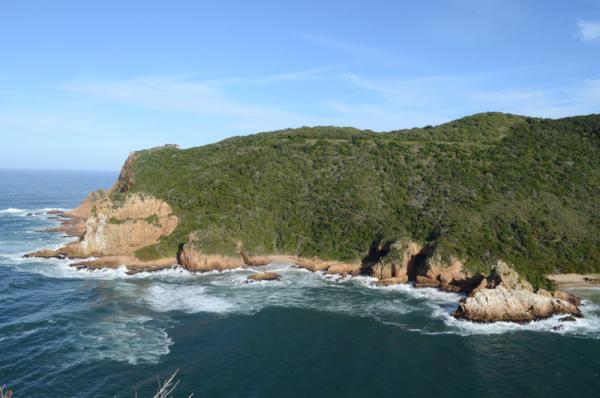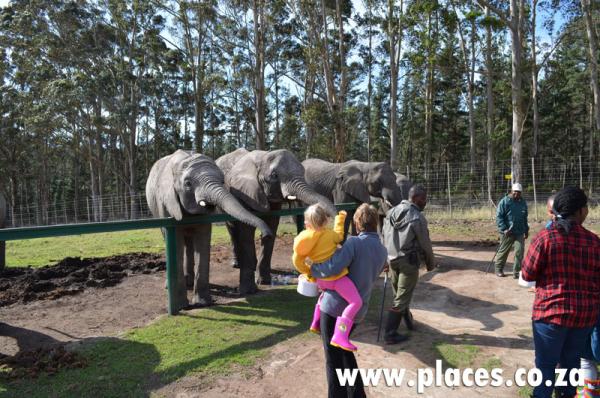

Knysna, on the Garden Route, offers an eclectic mix of attractions and activities - something for everyone.
Diverse in its mix of people and its surroundings, this diversity is reflected in a range of choices of eco-tourism, cultural-tourism and heritage-tourism.
Knysna is situated on South Africa's only National Lake, which is also the country's largest permanent estuary. The waters of the Indian Ocean channel through two large sandstone cliffs, The Heads, forming the gateway to the old harbour (Thesens Jetty) from where ships carried timber to the far corners of the globe, into the wide lagoon basin.
The enchanting town of Knysna is surrounded by the Outeniqua Mountain range, engulfed by indigenous indigenous forests and the protected 21 square kilometre marine reserve, locally better known as the 'Lagoon'.
The Knysna Lagoon is best known for its most unique industry, oyster farming. To the oyster lovers this could only mean sheer self-indulgence.
Adventure sports.
Lagoon cruises.
Scenic beauty.
Nature fynbos, forests and endangered species.
Bird watching and spot the elusive Knysna Loerie.
3 Championship golf courses.
Extravagant arts, culture and heritage experiences.
Fabulous shopping.
Wining and dining and an abundance of seafood, including the renowned Knysna oysters.
Fishing, boating, bait-collecting and all watersport activities on the lagoon are regulated, which ensures the protection of, and creates a sanctuary for, the threatened Seahorse (Hippocampus capensis), which breeds in the estuary, and the rare Pansy Shell, found along the flat sandbanks.
There are many fabulous Scuba diving and snorkelling spots, such as the wrecks at the Heads.
Canoeing, kayaking, a trip on a pleasure cruiser, or a ferry trip to Featherbed Nature Reserve, can be enjoyed on the Lagoon. Other activities include visiting Wilderness, Sedgefield and George, or Oudtshoorn, as well as bird-watching, with over 200 identified species, including the famous Knysna Lourie and the evasive Narina Trogon.
The varying and contrasting habitat found here is a haven for birds. These include marshland, vlei, rushes, fynbos, grassland and farmland.
Then there's the magnificent nature surrounding Knysna, whether you do scenic drives, mountain biking or hiking on the various hiking trails, exploring the mystical aura of the indigenous forests. These trails are clearly marked by interpretive boards, with information on forest ecology and management.
Among the 4 meter tree ferns and some 600-year old Outeniqua Yellowwood trees, such as the King Edward VII , one encounters beauty without equal. Here the Knysna Elephants still roam.
The other `delicacy' that has made Knysna famous, is its local brew. Various pubs, restaurants and cafes offer a tankard of the local draught beer - once tasted, you'll definately order another.
Knysna is also well known as the mecca of indigenous wood furniture, and the beauty of the area serves as an inspiration to artists, working with only the finest indigenous timber, carefully selected with pattern, grain and texture in mind, making every piece of furniture a masterpiece.
Over the years, Knysna has embraced many well-known creative people - writers, sculptors, potters, painters, jewellers, etc., and the art-lover will find delight in browsing through the many arts and crafts studios and galleries and shops.
For the culture-lover, the area is steeped in romantic history. Myth and legend unfold under the Oaks of Belvidere, with its old Manor House and Chapel, and will lead you through forest glades and glens, listening to the intrigue of Knysna's now legendary founder, George Rex, believed to have been fathered by King George lll of England.
Knysna will not fail to capture your imagination and sensitise you to this beautiful and fragile area, whose destiny hangs delicately between the very sensitive issues of development and conservation.
It is a place where past, present and future merge as one, and capture you in their web, forever.
This lovely town is a favourite holiday destination, best known for its
beautiful lagoon which empties into the sea through a spectacular mouth
known as The Heads.
The nearby forests have many lovely hiking trails and are home to a few elusive forest elephants.
The
water is clear and warm for most of the year, with the winter months
offering the best visibility, although good visibility of 15m (50ft) and
more can be expected under ideal conditions in December and January.
Up-welling
occurs after a strong south-easter, which makes the water much colder;
sea temperatures of as low as 9C (48F) have been recorded. There are no
major rivers flowing into the sea, except for the algae-rich water of
the Knysna Lagoon.
This does not greatly influence the
visibility but does bring nutrient-rich water to the nearby reefs,
encouraging prolific growth of invertebrate life.
The inviting
aquamarine to emerald green waters of the lagoon offer protected diving
even when the sea is rough, so the visiting diver does not have to leave
without the chance of getting wet.
The visibility changes
quickly with the tides and winds. The best time to dive is on high tide
when the ocean water pushes in as far as the bottom bridge over the
lagoon.
The lagoon area is under the protection of the National
Parks Board, whose offices can be found at the end of Thesen's Jetty.
They insist that divers tow or display the flag Alpha when diving in the
lagoon as boat traffic can be heavy and hazardous to the unwary.
Exciting
drift dives can be done on an incoming tide and a great distance can be
covered in a relatively short time. Local divers have covered the 3.5km
(2.25 miles) from the Heads to Thesen's Jetty in a time of one hour and
20 minutes.
Non-diving companions can go for long and scenic
walks in the nearby forest, do a bicycle or horse trail, paddle a canoe
across the lagoon, explore the Featherbeds Nature Reserve, visit a
museum or even pan for gold in one of the streams in the forest.
If this all sounds too energetic, there are a number of good coffee shops, restaurants, pubs and craft shops to visit.
DAGLEISH BANK
Access: By boat launched through The Heads or from Buffels Bay.
Average depth: 30m (100ft)
Maximum depth: Beyond sport diving depths.
A
large pinnacle rising to 27m (90ft) below the surface, this fabulous
reef is covered in colourful hard and soft coral and hosts a multitude
of big gamefish, rockcod and other species. Dagleish Bank is a dive site
that is not regularly visited due to the rather long distance from the
launch sites, and is therefore still relatively unspoilt.
EAST CAPE REEF
Access: By boat launched through The Heads.
Conditions: Diving is possible even when there are fairly big swells running.
Average depth: 20m (65ft)
Maximum depth: 24m (80ft)
There
are overhangs, drop-offs and caverns covered in soft corals. Game fish,
rays and sharks, such as ragged-tooths are often seen. This reef is so
extensive that its can only be fully explored by doing a number of
dives.
Then there are also Bruce's Bank and The Pinnacle diving
sites, as well as wreck-diving on The Fairholme (1888), The Paquita
(1903) and The Phantom wrecks, with fascinating little seahorses to be
found at Thesen's Jetty, under the jetty itself, and not in the
junkyard!
This wide strip of dense timberland, which includes Diepwalle Forest,
Garden of Eden, Goudveld Forest, Groeneweide Nature Walk and Jubilee
Creek, covers a total of 60 500 ha on the southern slopes of the
Outeniqua Mountains between Mossel Bay and the Krom River near
Humansdorp
The Animals to be found in this forested wonderland
include one last surviving cow belonging to the famous Knysna elephant
herd, leopard, bushpig, baboon, vervet monkey honey badger, bushbuck and
blue duiker. But it is for their trees and the birdlife they support
that these forests are most noteworthy Species include stinkwood,
kalander, kershout, hard pear, white pear, yellowwood, assegai and the
pink-flowered Cape chestnut.
The colourful Knysna lourie, the
Narina trogon, wood owl, Rameron pigeon and Knysna scrub warbler are
among the birds that live in the high forest canopy. The mountain
buzzard, Cape eagle owl and crowned eagle can also be seen in the
forests and surrounding mountains.
Set in the heart of the famous Garden Route, this magnificent trail
leads through indigenous forests and montane fynbos, majestic mountain
scenery, views of the coastal plateau, relics of the gold rush near
Millwood, bird and animal life of the forest and fynbos, mountain
streams and pools.
The forest and the wet fynbos depend on high rainfall, so be prepared for rain and mist.
The
Outeniqua Hiking Trail is a 7 day trail with 8 overnight huts. Hikers
do not have to hike the full 7 days; 2 or 3 days are allowed.
The
trail may only be done in one direction - from West to East. The total
distance of the trail is 108km. The terrain rating is from easy to
difficult.
Facilities
The huts offer shelter, firewood,
grids, water and rudimentary bedding; no pots. There is only
electricity at Diepwalle & Harkerville huts.
Minimum of two and niaximum of 24 hikers allowed on trail.
Hut 1: Beervlei
Start of hiking trail & vehicles may be parked at Beervleihut.
Hut 2: Windmeulnek
Windmeulnek
hut is about16km or 5hrs hike from Beervlei. The nearest parking to
Windmeulnek is Karatara, which is 8 kIn. A 2-day circular trail can be
hiked here.
Hut 3: Platbos
Platbos is about 17 km ( 5hrs
hike) from Windmeulnek. Farleigh Forest Station is 2 km from Platbos
hut. Vehicles can be parked at Farleigh Parking Area or at Karatara.
Hut 4: Millwood
Millwoodis 15km ( 5 hrs) from Platbos. Cars must be parked at Goudveld ParkingArea .A circular trail can be hiked here.
Hut 5: Rondebossie
Rondebossiehut is 17km from Millwoodhut. Parking is only allowed at Gouna Forest Station.
Hut 6: Diepwalle
A
very popular hut with electricity and warm water. Braai facilities are
either in the open or under roof ( when it rains). The Diepwalle hut is
13km (5hrs ) from Rondebossie and 17 kIn (5 hrs) from Fisantehoek.
Hut 7: Fisantehoek
At Fisantehoek no cars are allowed. The hut is 16km (5hrs) from Diepwalle.
Hut 8: Harkerville
Very
popular hut as it is the end of the Outeniqua and also the beginning of
the very popular Harkerville Coast Hiking Trail. The Harkerville hut
can accommodate12 in the outside room. This hut also has electricity and
warm water. Vehicles must be parked at Harkerville Forest Station and
not at the hut.
Bookings
SA National Parks
PO Box 3542, Knysna, 6570
Tel.+27(0) 44-302-5606
Fax +27(0) 44-302-5627
Source & more info
Garden Route National Park







